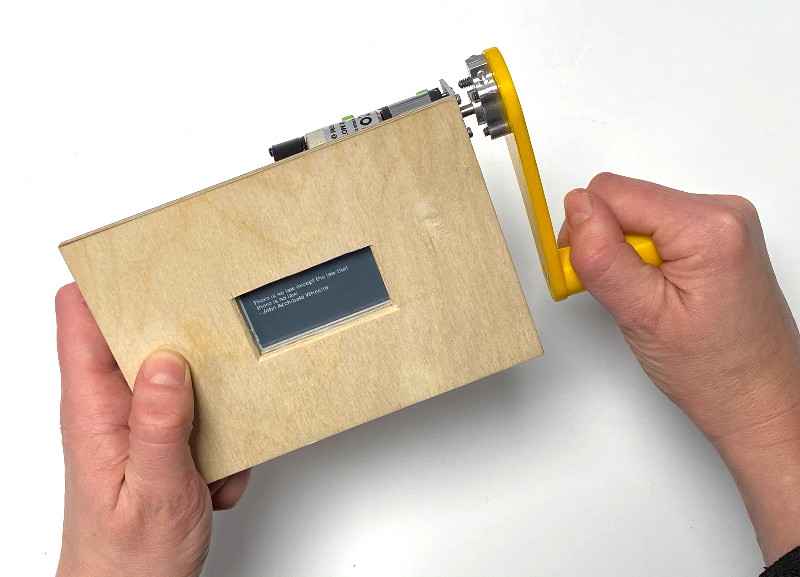You will learn to identify sensors, actuators, interaction platforms, and physical materials that are needed and use these to develop prototypes and systems. We specifically work with different ways of sketching and building prototypes of various kinds including paper prototypes, role plays, video, mockups, small-scale and full scale models with different levels of implemented functionality. Through guest lectures, insight in how physical interaction design is realised in different domains is also given.
DH2400 Physical Interaction Design and Realization 7.5 credits

In this course you will learn to create interactive systems that work outside the conventional laptop/tablet/smartphone paradigm, to suit specific physical use situations. You will learn to identify the sensors, actuators, microcontrollers and materials needed, and use these to make prototypes of different levels of fidelity.
Main contents
-
Analysing and developing interaction design concepts based on a physically complex use context
-
Methods for envisioning, sketching, and illustrating physical interaction
-
Understanding the design potential of different materials and technologies
-
Elements of industrial design: making physical models, mockups and prototypes using different tools and materials
-
Theory related to embodied interaction and interaction with physical objects
-
State of the art devices, tools, products and systems, as well as knowledge of recent research projects in the area
-
Electronic circuit basics, including resistors, capacitors, LEDs and different conductive and resistive materials
-
Sensors and actuators: construction, uses and application
-
Using prototyping microcontrollers for putting together a working interactive system
Examination
Examination is divided into several parts, including online quizzes, reading seminars, and project work. You will see specific instructions of the individual parts and activities, and will also be able to follow the assessment of them on Canvas.
Course literature
Online research papers and other sources listed in course assignments.
Information per course offering
Choose semester and course offering to see current information and more about the course, such as course syllabus, study period, and application information.
Information for Spring 2025 interak programme students
- Course location
KTH Campus
- Duration
- 17 Mar 2025 - 2 Jun 2025
- Periods
- P4 (7.5 hp)
- Pace of study
50%
- Application code
60238
- Form of study
Normal Daytime
- Language of instruction
English
- Course memo
- Course memo is not published
- Number of places
Places are not limited
- Target group
Open for all programmes from year 3, and for students admitted to a master's programme, provided that the course can be included in the programme.
- Planned modular schedule
- [object Object]
- Schedule
- Part of programme
Master's Programme, Computer Science, åk 1, CSID, Conditionally Elective
Master's Programme, ICT Innovation, åk 2, HCID, Mandatory
Master's Programme, ICT Innovation, åk 2, HCIN, Mandatory
Master's Programme, Interactive Media Technology, åk 1, Conditionally Elective
Master's Programme, Interactive Media Technology, åk 2, Conditionally Elective
Contact
Ylva Fernaeus, e-post: fernaeus@kth.se
Course syllabus as PDF
Please note: all information from the Course syllabus is available on this page in an accessible format.
Course syllabus DH2400 (Spring 2020–)Content and learning outcomes
Course contents
Intended learning outcomes
Having passed the course, the student should be able to
- analyse and develop concepts for human computer interaction based on physical properties in a specific use context
- apply methods to stage, sketch and illustrate physical interaction
- account for how different materials and technologies can be combined in interactive systems
- apply selected parts of industrial design: production of physical models, mockups and prototypes with different tools and materials
- account for theory of physical interaction and interaction with physical objects
- discuss popular platforms, tools, products, systems, and research projects in the area
- through prototype development practically apply basic understanding of electronic circuits including resistance, capacitors, light-emitting diodes and different leading and resistive materials and sensors and actuators.
- implement a functioning interactive system based on specific physical circumstances
- reflect on design of physical interactive systems taking into consideration the preconditions and needs of people and the aim of the society for economic, social and ecologically sustainable development
in order to be able to create interactive systems better adapted to specific situations for physical use outside the conventional graphical interface paradigm .
Literature and preparations
Specific prerequisites
Completed course in human computer interaction DH2620/DH1620/DH2624 or equivalent.
Recommended prerequisites
Basic electronics knowledge corresponding to MF1035 Electrical Engineering, Basic Course Media or DM1588 Sensor Programming for Media Technology.
Equipment
Literature
Examination and completion
If the course is discontinued, students may request to be examined during the following two academic years.
Grading scale
Examination
- PRO1 - Project, 7.5 credits, grading scale: P, F
Based on recommendation from KTH’s coordinator for disabilities, the examiner will decide how to adapt an examination for students with documented disability.
The examiner may apply another examination format when re-examining individual students.
Opportunity to complete the requirements via supplementary examination
Opportunity to raise an approved grade via renewed examination
Examiner
Ethical approach
- All members of a group are responsible for the group's work.
- In any assessment, every student shall honestly disclose any help received and sources used.
- In an oral assessment, every student shall be able to present and answer questions about the entire assignment and solution.
Further information
Course room in Canvas
Offered by
Main field of study
Education cycle
Add-on studies
Please discuss with the instructor.
Contact
Supplementary information
In this course, the EECS code of honor applies, see:
http://www.kth.se/en/eecs/utbildning/hederskodex
The number of participants is limited.
The selection process will be based on the following criteria:
Spring term 2018:
- Students who have the course as a compulsory course in the interactive media master programme, track physical interaction
- Students admitted to the interactive media programme,
- Other KTH-students interested in the course
Autumn term 2018:
- EIT-students
- Students admitted to the interactive media programme,
- Other KTH-students interested in the course